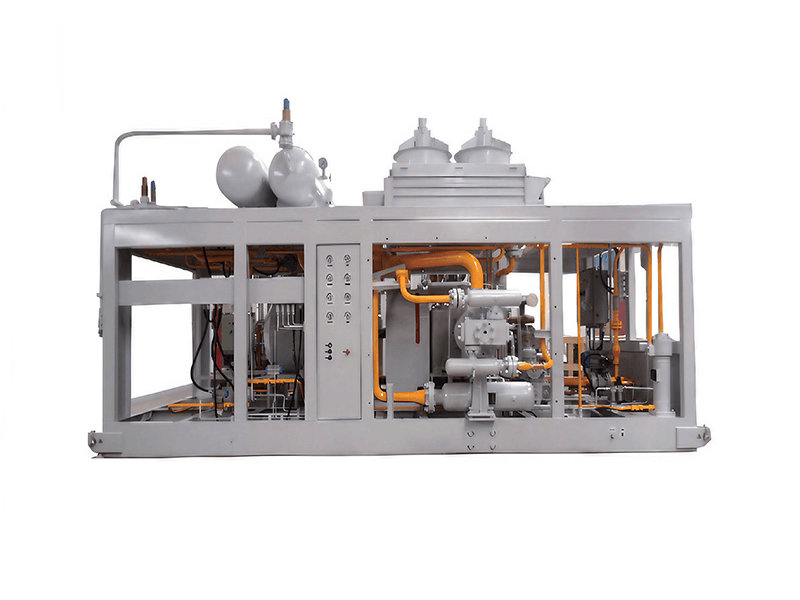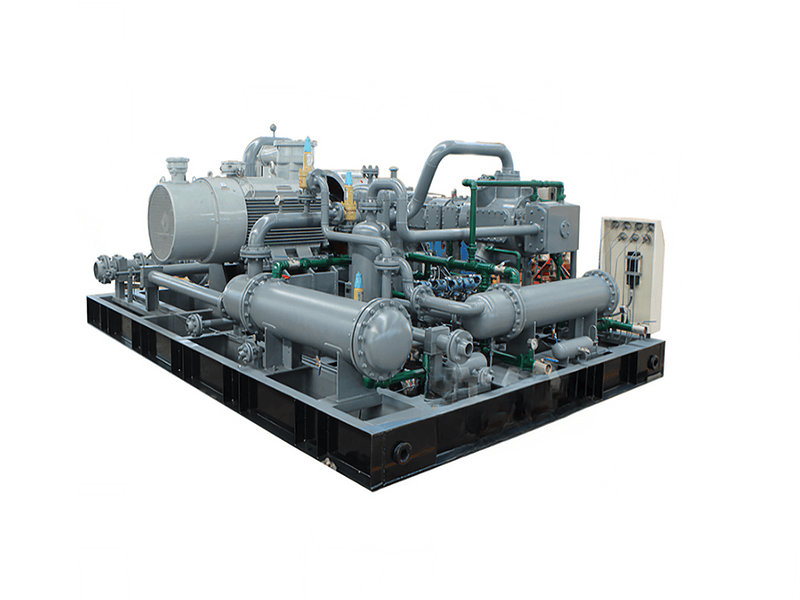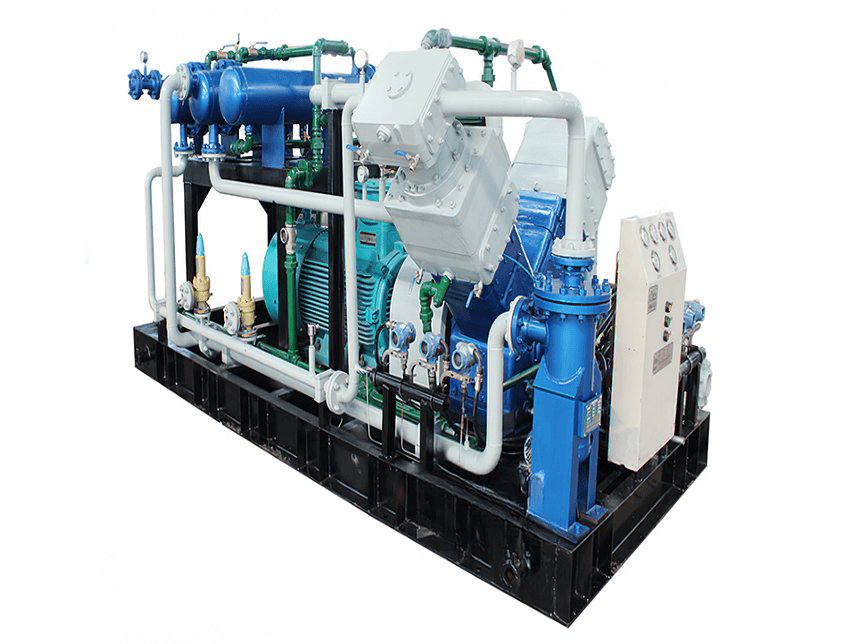A piston natural gas compressor, also known as a reciprocating natural gas compressor, consists of several key components that work together to compress the gas using a reciprocating motion. Here are the primary components of a piston natural gas compressor:
1. Cylinder: The cylinder is a cylindrical chamber where the reciprocating motion of the piston takes place. It is typically made of robust materials capable of handling high pressures. The cylinder is designed to contain the natural gas during compression.
2. Piston: The piston is a cylindrical component that moves back and forth inside the cylinder. It is connected to a crankshaft and converts the rotary motion of the driver into reciprocating motion. The piston creates compression by displacing the natural gas within the cylinder.
3. Valves: Piston compressors have two types of valves: suction valves and discharge valves. Suction valves allow the natural gas to enter the cylinder during the suction stroke, while discharge valves enable the compressed gas to exit the cylinder during the compression stroke. The valves open and close based on the piston's position and pressure differentials to ensure proper gas flow.
4. Crankshaft: The crankshaft is a rotating shaft connected to the piston. It converts the reciprocating motion of the piston into rotary motion, which is then transmitted to the driver, such as an electric motor or an internal combustion engine.
5. Driver: The driver provides the mechanical power to drive the reciprocating motion of the piston. It can be an electric motor, a gas engine, or a diesel engine, depending on the specific application and power requirements.
6. Lubrication System: Piston compressors require a lubrication system to reduce friction and wear between moving parts. The lubrication system supplies lubricating oil to the piston, cylinders, and other critical components to ensure smooth operation and extend the compressor's lifespan.
7. Cooling System: Compressing natural gas generates heat, so piston compressors require a cooling system to maintain the operating temperature within safe limits. This can involve air or water cooling methods, such as intercooling or aftercooling, to remove heat from the compressed gas.
8. Control and Monitoring Systems: These systems include instruments, sensors, and control devices to regulate and monitor the operation of the compressor. They ensure proper functioning, safety, and efficiency of the compression process. Control systems may include pressure, temperature, and vibration monitoring, as well as safety shutdown systems and automated control interfaces.
9. Piping and Connections: The compressor is connected to the suction and discharge lines through piping and fittings. Suction piping brings the natural gas to the compressor, while discharge piping carries the compressed gas to the downstream system.
10. Safety Systems: Safety features, such as pressure relief valves, emergency shutdown systems, and other safety devices, are essential to protect the compressor and personnel from overpressure, leaks, or other hazardous conditions.
11. Frame or Skid: The compressor unit is typically mounted on a sturdy frame or skid, providing structural support and ease of installation. The frame or skid also helps to reduce vibration and ensure proper alignment of the components.
12. Cylinder Cooling: In addition to the overall cooling system, piston compressors often incorporate cylinder cooling methods to maintain the temperature of the cylinder walls. This can involve the use of fins or cooling jackets around the cylinders, which facilitate heat dissipation and prevent overheating.
13. Gas Scrubbers and Filters: Gas scrubbers and filters are included in the system to remove any contaminants or impurities present in the natural gas stream. These components help protect the compressor and downstream equipment from damage and ensure the gas meets the required quality standards.
14. Suction and Discharge Silencers: To reduce noise generated during the compression process, suction and discharge silencers are typically installed in the compressor system. These specialized components help attenuate the noise produced by the gas flow, improving the overall acoustic performance.
15. Vibration Isolation: Piston compressors can generate significant vibrations during operation. To minimize the transmission of vibrations to the surrounding structure, vibration isolation devices, such as rubber mounts or dampers, are often employed. These devices help reduce noise and prevent damage to the compressor and its surroundings.
16. Control Panel: A control panel houses the electrical controls and instrumentation for operating and monitoring the compressor system. It includes switches, indicators, gauges, and control interfaces that allow operators to manage the compressor's performance, safety features, and operational parameters.
17. Maintenance and Service Access: Piston compressors are designed with features that facilitate maintenance and service activities. These can include easy access to components, removable panels for inspection and maintenance, and clear labeling or identification of critical parts.
It's important to note that the specific configuration and features of a piston natural gas compressor can vary depending on the manufacturer, model, and application requirements. Customizations or additional components may also be added based on specific needs, site conditions, or industry standards.
Maintenance of a piston natural gas compressor
Maintenance of the components in a piston natural gas compressor is crucial to ensure the reliable and efficient operation of the compressor system. Here are some general guidelines for maintaining the key components:
1. Cylinder and Piston:
- Regularly inspect the cylinder walls for signs of wear, scoring, or corrosion. Clean and remove any deposits or contaminants.
- Check the piston rings for wear or damage. Replace them if necessary to maintain proper sealing and compression efficiency.
- Monitor and maintain proper lubrication of the cylinder walls and piston to reduce friction and wear.
- Keep the cylinder cooling system clean and free from blockages to ensure effective cooling.
2. Valves:
- Inspect the suction and discharge valves regularly for proper seating, wear, or damage. Clean or replace valves as needed.
- Check valve springs, retainers, and other valve components for signs of wear or fatigue. Replace them if necessary.
- Ensure proper valve clearance and adjust as per manufacturer's recommendations.
- Keep the valves clean and free from debris or deposits that can affect their operation.
3. Crankshaft and Bearings:
- Monitor bearing temperatures and lubrication levels regularly. Maintain proper lubrication to minimize wear and extend bearing life.
- Inspect the crankshaft for alignment, balance, and signs of fatigue or damage. Address any issues promptly to prevent further damage.
- Check bearing clearances and replace worn or damaged bearings according to manufacturer's recommendations.
4. Lubrication System:
- Follow the manufacturer's guidelines for lubrication schedule and recommended lubricants.
- Regularly check lubricant levels, oil filters, and perform oil analysis to ensure proper lubrication and identify potential issues.
- Clean or replace oil filters as recommended by the manufacturer.
- Inspect lubrication lines, fittings, and connections for leaks or blockages.
5. Cooling System:
- Clean cooling fins, heat exchangers, or cooling jackets regularly to ensure proper heat dissipation.
- Monitor coolant levels, flow rates, and temperatures. Flush and replace coolant as per manufacturer's recommendations.
- Inspect and maintain cooling system components, such as fans, pumps, and radiators, to ensure their proper functioning.
6. Control and Monitoring Systems:
- Regularly calibrate and test pressure, temperature, and vibration sensors to ensure accurate readings.
- Check control system settings and alarms to ensure they are properly configured and functioning.
- Perform routine checks on control panel displays, switches, and indicators for proper operation.
7. Piping and Connections:
- Inspect suction and discharge piping for leaks, corrosion, or damage. Repair or replace damaged sections as necessary.
- Check piping supports and hangers to ensure proper alignment and support.
- Regularly inspect and clean filters and separators in the gas lines to prevent contamination.
8. Safety Systems:
- Test and verify the proper functioning of safety systems, including pressure relief valves and emergency shutdown mechanisms.
- Follow recommended inspection and testing intervals for safety systems as per regulations and manufacturer's guidelines.
9. Maintenance Records:
- Maintain comprehensive maintenance records, including inspection dates, findings, and any maintenance or repairs performed.
- Follow the manufacturer's recommended maintenance schedule and consult their manuals for specific maintenance procedures and intervals.
10. Frame and Skid:
- Inspect the frame or skid for any signs of corrosion, cracks, or structural damage. Repair or reinforce as necessary.
- Ensure that the compressor unit is securely mounted on the frame or skid and that all fasteners are properly tightened.
- Lubricate any moving parts or bearings associated with the frame or skid.
11. Gas Scrubbers and Filters:
- Regularly inspect and clean gas scrubbers and filters to remove accumulated contaminants. Replace filter elements as recommended by the manufacturer.
- Maintain a schedule for replacing or cleaning filter elements based on the operating conditions and gas quality.
12. Suction and Discharge Silencers:
- Inspect silencers for signs of damage or blockages. Clean or replace silencer elements if necessary.
- Check the mounting and connections of the silencers to ensure proper alignment and minimize vibration transmission.
13. Vibration Isolation:
- Periodically inspect vibration isolation devices, such as rubber mounts or dampers, for wear or damage. Replace them if needed.
- Verify that the compressor unit is securely mounted on the vibration isolation devices to minimize vibrations.
14. Control Panel:
- Regularly check the control panel for proper operation, including switches, indicators, and displays. Replace or repair any faulty components.
- Verify the accuracy of control panel instrumentation and sensors through calibration and testing.
15. Electrical Components:
- Inspect electrical connections, wiring, and insulation for signs of wear, damage, or overheating. Repair or replace as necessary.
- Check motor or engine brushes and commutators for wear. Clean or replace them as needed.
- Regularly inspect and clean electrical enclosures and cabinets to prevent dust buildup or moisture ingress.
16. Safety Systems:
- Test safety systems, such as pressure relief valves and emergency shutdown mechanisms, periodically to ensure their proper operation.
- Verify that safety systems are appropriately labeled and that personnel are trained on their operation and response procedures.
17. Regular Maintenance Schedule:
- Create a comprehensive maintenance schedule that includes routine inspections, lubrication, filter replacements, and other preventive maintenance tasks.
- Follow the maintenance schedule diligently and document all maintenance activities performed.
18. Training and Compliance:
- Ensure that maintenance personnel are trained on proper maintenance procedures and safety protocols.
- Stay up to date with industry regulations and compliance requirements related to the operation and maintenance of natural gas compressors.
By following these maintenance practices and adhering to the manufacturer's guidelines, you can help ensure the longevity, efficiency, and safe operation of a piston natural gas compressor system. It is important to consult the specific documentation and recommendations provided by the manufacturer for detailed instructions and maintenance intervals tailored to your compressor model.


























